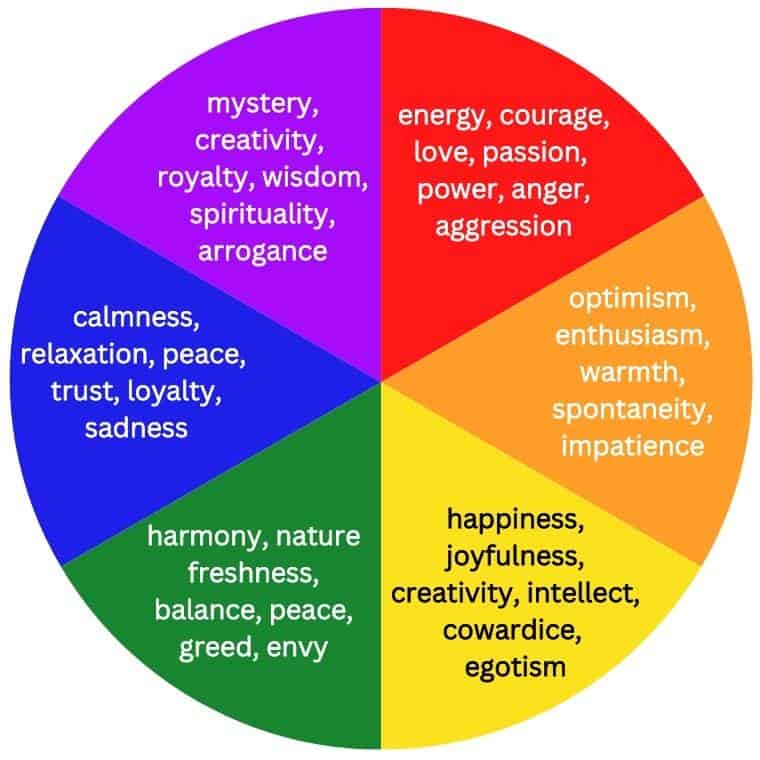There are plenty of emotions in color. Discover how colors influence moods, feelings, and even behaviors.
Colors are unique because they convey meanings and emotions. They can change moods and influence your feelings and behavior through their emotional effects. However, color emotions are a personal experience that differs from person to person.
In this post, we’ll discuss the emotions of colors and how they impact feelings, moods, or behaviors.
Color Mood Chart
There are lots of emotions in colors. To simplify things, we have prepared a color emotion chart to summarize all the emotions associated with colors.
However, shades can have a color bias (i.e., they lean towards a specific hue more), which can change or impact the associated emotions and moods.
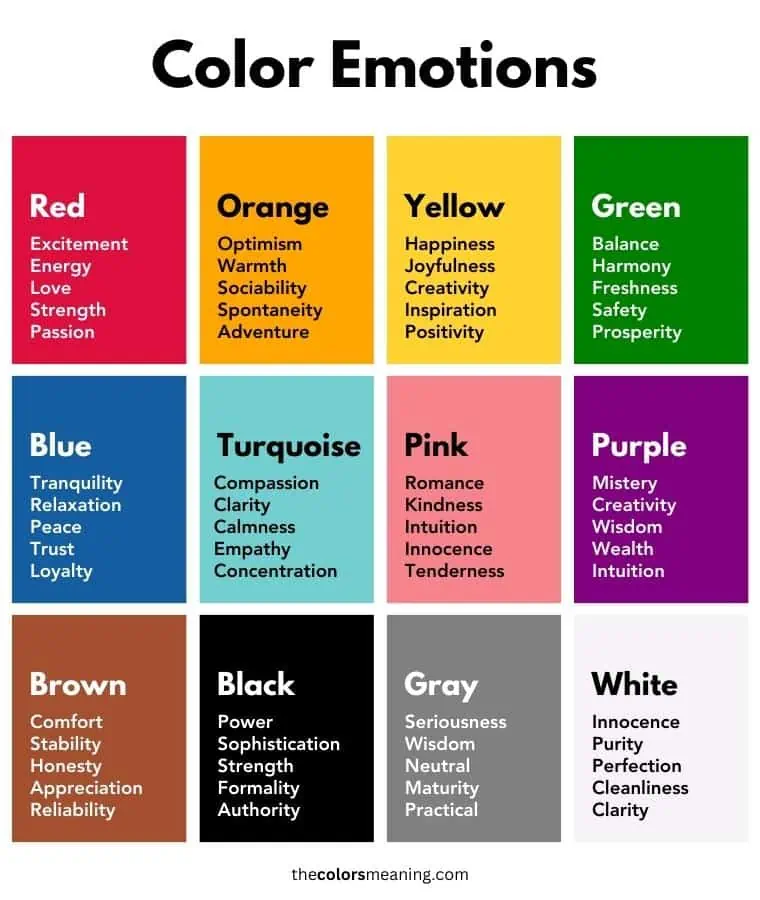
Therefore, we only used pure hues for the color emotion chart below.
- Red: passion, energy, anger, aggression,
- Orange: optimism, excitement, adventure
- Yellow: happiness, joyfulness, stimulating
- Green: harmony, fertility, prosperity, growth
- Blue: tranquility, relaxation, loyalty, serene
- Purple: mystery, luxury, royalty, wisdom
- Pink: romance, innocence, sophistication, kindness
- Brown: comfort, earthiness, stability, security
- Black: powerful, authoritative, elegance
- White: innocence, purity, simplicity, and cleanliness
Warmth and Cool Colors as Emotions
There are two types of color moods: the warm, active, and exciting qualities of red and its analogous hues (yellow and orange) and the cool, passive, and calming properties of blue, purple, and green.
Warmth colors – such as red, orange, and yellow – evoke emotions ranging from warmth and enthusiasm to anger and aggression. Cool colors like blue, green, and purple exude feelings of calmness and peace, as well as sadness, envy, and arrogance.
Happy Mood Colors
The colors associated with happiness and joy are warm hues. The cheerful colors are yellow, orange, red, and pink. They are also called happy mood colors because they are associated with happiness, optimism, positivity, enthusiasm, energy, and spontaneity.
While yellow is linked to feelings of happiness, cheerfulness, and creativity, orange conveys warmth, optimism, and enthusiasm. On the other hand, red is associated with energetic and action-packed moods. It can increase your courage and strength. It is the most stimulating of all.
What colors represent happiness? Yellow is definitely the happiest.
| Hue | Happy Colors | Hex Code |
|---|---|---|
| Yellow | #FFFF00 | |
| Amber | #FFBF00 | |
| Light Pink | #FFC0CB | |
| Orange | #FFA500 | |
| Early Spring Green | #B7E7B0 | |
| Peach | #FFE5B4 | |
| Happy Red | #EC6B76 |
Sad Mood Colors
Colors that evoke sad emotions and can affect your mood tend to be dark, cold, or muted colors. These include gray, blue, dark green, and black. Therefore, these are perceived as sad colors.
Gray is perceived as the saddest color because it reminds us of cloudy weather, storms, and rain.
Gray is followed by indigo, black, and blue.
Although it is said that blue can trigger depression, this is a misconception. When overused, this color can instead be associated with low mood feelings or melancholy. On the other hand, blue is a soothing color, and we will not include it in this list.
Black is also a sad mood color associated with depression, sadness, pessimism, fear, or loss.
Wondering what colors represent sadness? Gray is the color of sadness, but black, blue, and dark green are also on the list.
| Hue | Sad Colors | Hex Code |
|---|---|---|
| Gray | #808080 | |
| Indigo | #4B0082 | |
| Black | #000000 | |
| Dark Blue | #00008B | |
| Dark Purple | #301934 |
Comforting Mood Colors
Colors that convey emotions of comfort are cool colors, and these include blue, green, and purple. They are relaxing and soothing. The lighter or more pastel they are, the more tranquility they evoke.
Moreover, a sense of comfort is also provided by neutrals, especially lighter shades such as beige, greige (a soft mixture of gray and beige), and light shades of gray or white.
Light brown is also an excellent choice if you want to create a warm and relaxing atmosphere. It is relaxing, comfortable and warm. Moreover, this color is related to stability and safety.
| Hue | Comforting Colors | Hex Code |
|---|---|---|
| Light Blue | #ADD8E6 | |
| Soft Blue | #ABD7EB | |
| Sky Blue | #87CEEB | |
| Pale Teal | #6B9797 | |
| Gentle Green | #D3EEDD | |
| Buff | #E7DBCC | |
| Lilac | #C8A2C8 | |
| Mother of Pearl | #F0E3E0 |
Energizing Mood Colors
Colors that are energizing and uplifting are bright or neon colors. These include red, bright shades of green and yellow shades with green undertones.
Red is the most stimulating and energizing color, symbolizing courage, energy, and action. Furthermore, red is the color with the most emotional associations. It is intense and grabs attention most easily out of the whole color spectrum.
Green is linked to nature, associated with feelings of relaxation, generosity, and harmony. What’s more, it is very revitalizing.
If you want a high-energy mood, choose red. On the other hand, if you wish for something revitalizing but relaxing at the same time, choose green.
| Hue | Energizing Colors | Hex Code |
|---|---|---|
| Imperial Red | #ED2939 | |
| Electric Crimson | #FF003F | |
| Flame Red | #E25822 | |
| Dutch Orange | #FF9B00 | |
| Pumpkin | #F5761A | |
| Bumblebee Orange | #FFC82A |
Emotions of Colors
Here’s a list of colors associated with several emotions:
- Red: Passion, Strength, and Energy
- Orange: Enthusiasm, Spontaneity, and Warmth
- Yellow: Happiness, Cheerfulness, and Optimism
- Green: Balance, Growth, and Harmony
- Blue: Calmness, Trust, and Stability
- Purple: Creativity, Wisdom, and Compassion
- Pink: Love, Romance, and Kindness
- Brown: Stability, Honesty, and Warmth
- Black: Power, Sophistication, and Authority
- White: Purity, Innocence, and Delicacy
- Gray: Neutrality, Seriousness, and Maturity
However, this is a summary of the color emotions. Let’s explore more.
Colors as Emotions
Although there is an emotional color grouping, each color conveys different emotions.
Moreover, each pure hue has plenty of shades. Even if they are in the same color family, these shades can convey different meanings and affect your mood differently.
Red
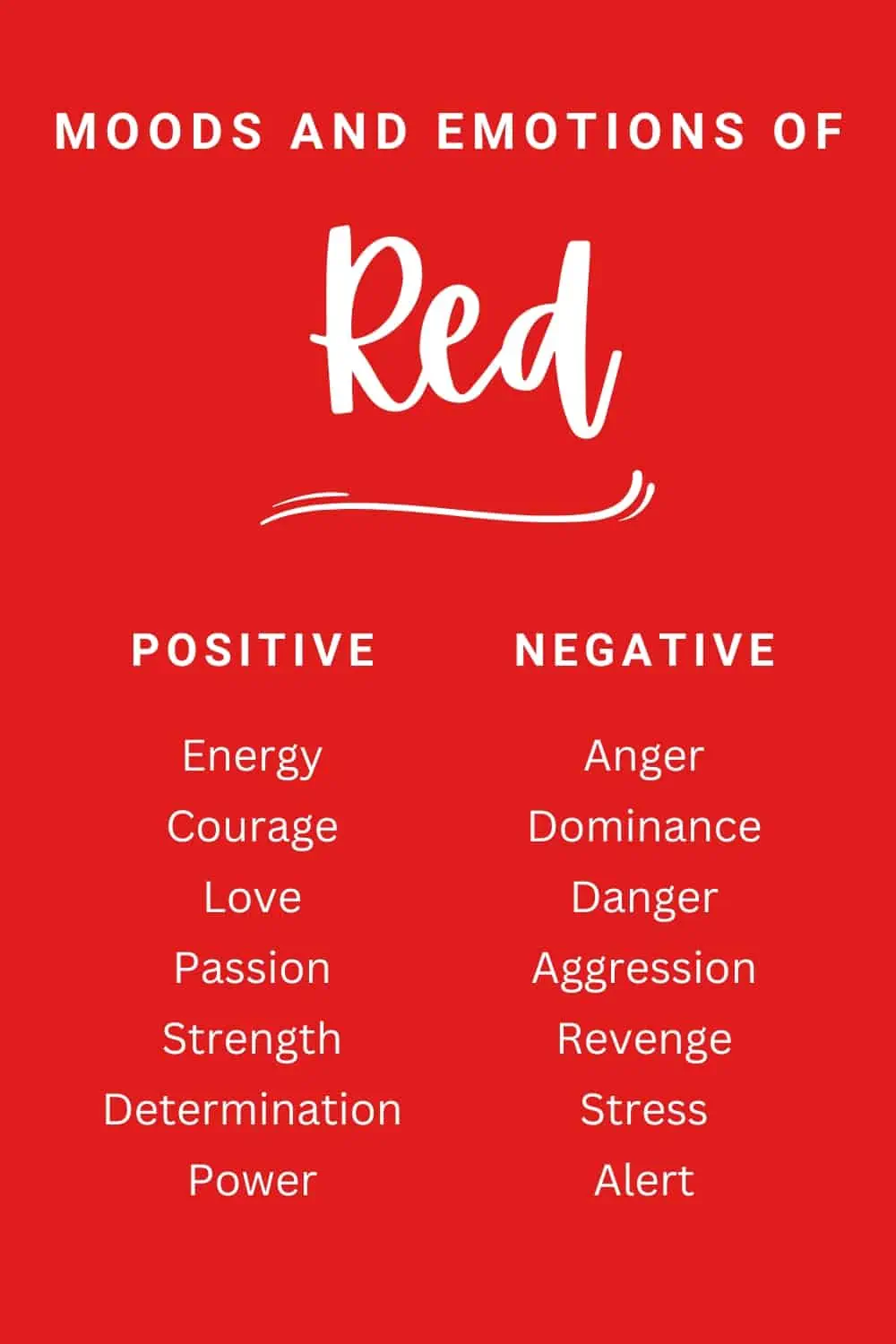
The color red calls to mind feelings of action, love, and passion. Moreover, it symbolizes strength, determination, and courage. That’s why the red carpet is used at celebrity events.
On the other hand, it is often associated with anger, aggression, and revenge. Hence the expression “seeing red,” which means being very angry.
Since it has the longest wavelength in the visible spectrum, red is one of the most attention-grabbing colors. As an aside, it is second only to yellow.
Besides capturing attention easily, it keeps you there. Because it creates a sense of urgency, it is often used for alerts or errors in web design. For example, you often see red fields when something goes wrong in the booking flow of a website.
In addition to color emotions, this color of action stimulates metabolism, which leads to increased appetite. This is the basis of decorating restaurants with this color.
Orange
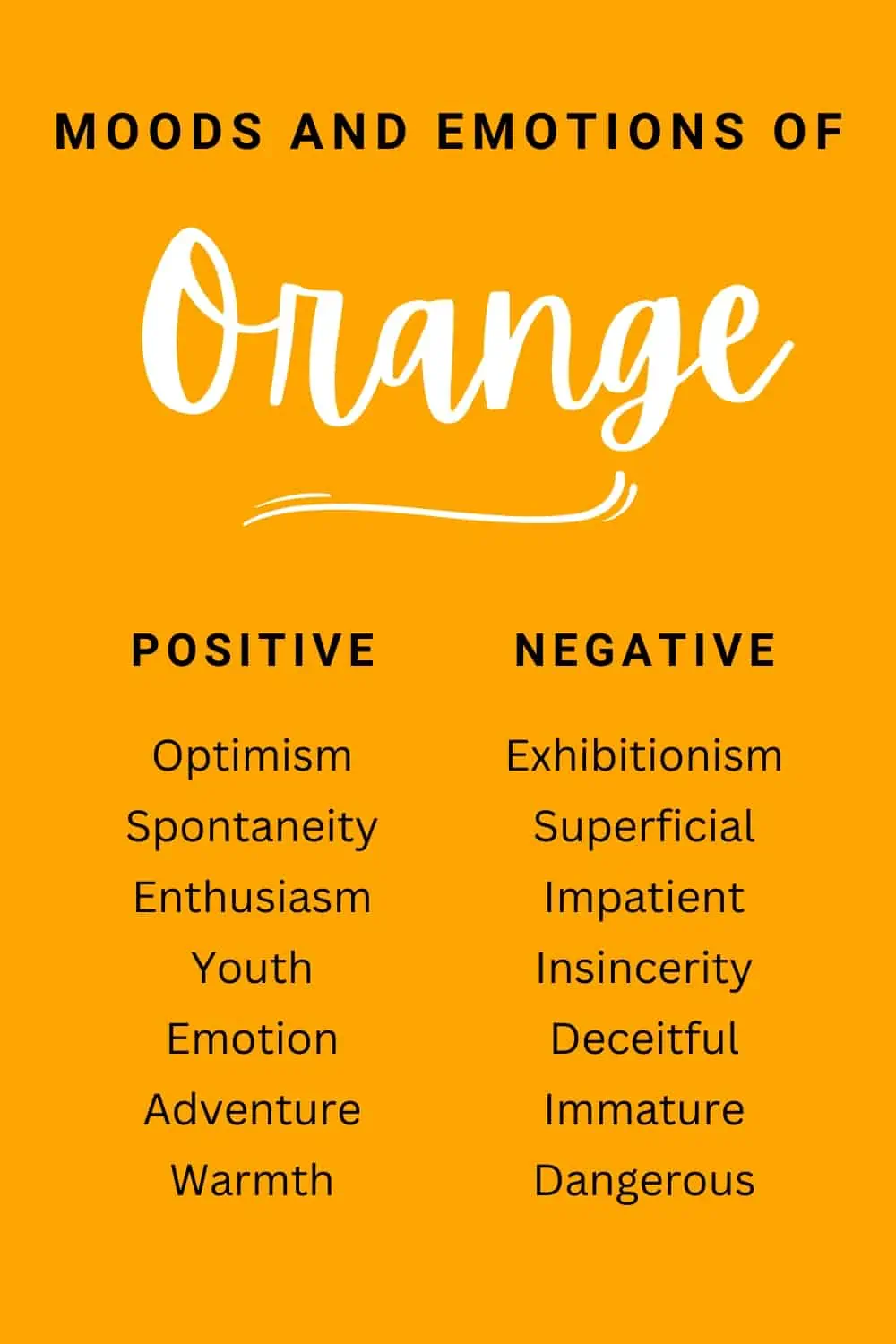
Orange shares the emotions of its pure hues, namely the energy of red and the optimism of yellow.
It is also associated with feelings of excitement, warmth, and positivity. As a result, orange is associated with a positive, slightly energetic, and enthusiastic mood.
Orange is the color of emotion that encourages, stimulates, and uplifts. Furthermore, it is said to enhance creativity.
Thanks to its enthusiasm, orange is often used in web design to keep the audience excited. This secondary color symbolizes adventure and youth and can increase spontaneity.
It is sometimes used in road signs because it attracts attention but not as much as red.
On the other hand, orange can symbolize superficiality, impatience, deceitfulness, and exhibitionism.
Yellow
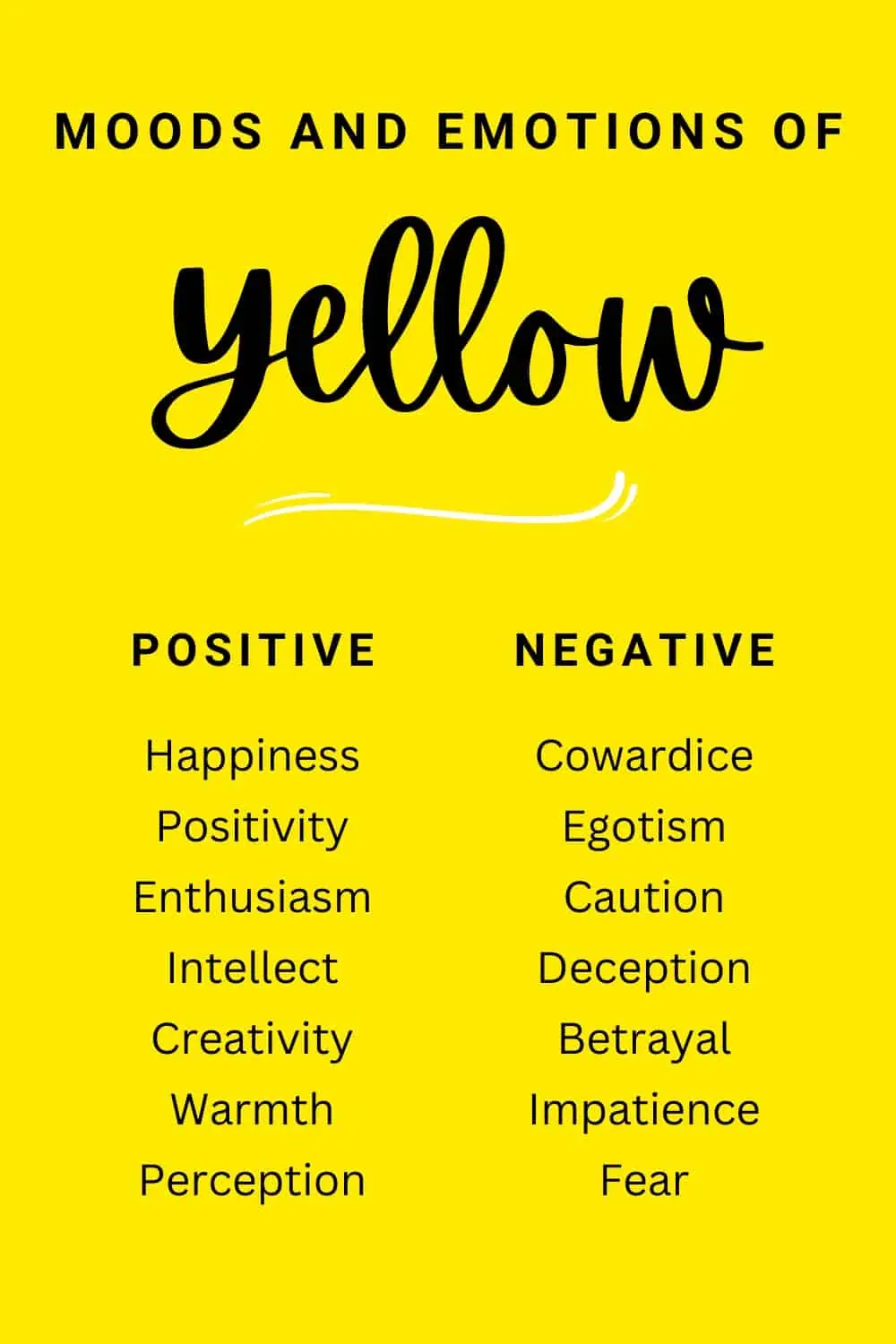
Yellow is the color of happiness. Moreover, it is associated with emotions of warmth, joy, and fun. Yellow is also the color of mind, intellect, and creativity. It is closely related to acquired knowledge and resonates with the logical side of the brain (the left side). This means it facilitates mental agility and perception.
The mood of yellow is linked to its effects: it inspires, amuses, and energizes.
Moreover, it is the most attention-grabbing color of the visible spectrum. For this reason, it has been used as a taxi color since 1969 in the United States (New York).
Green
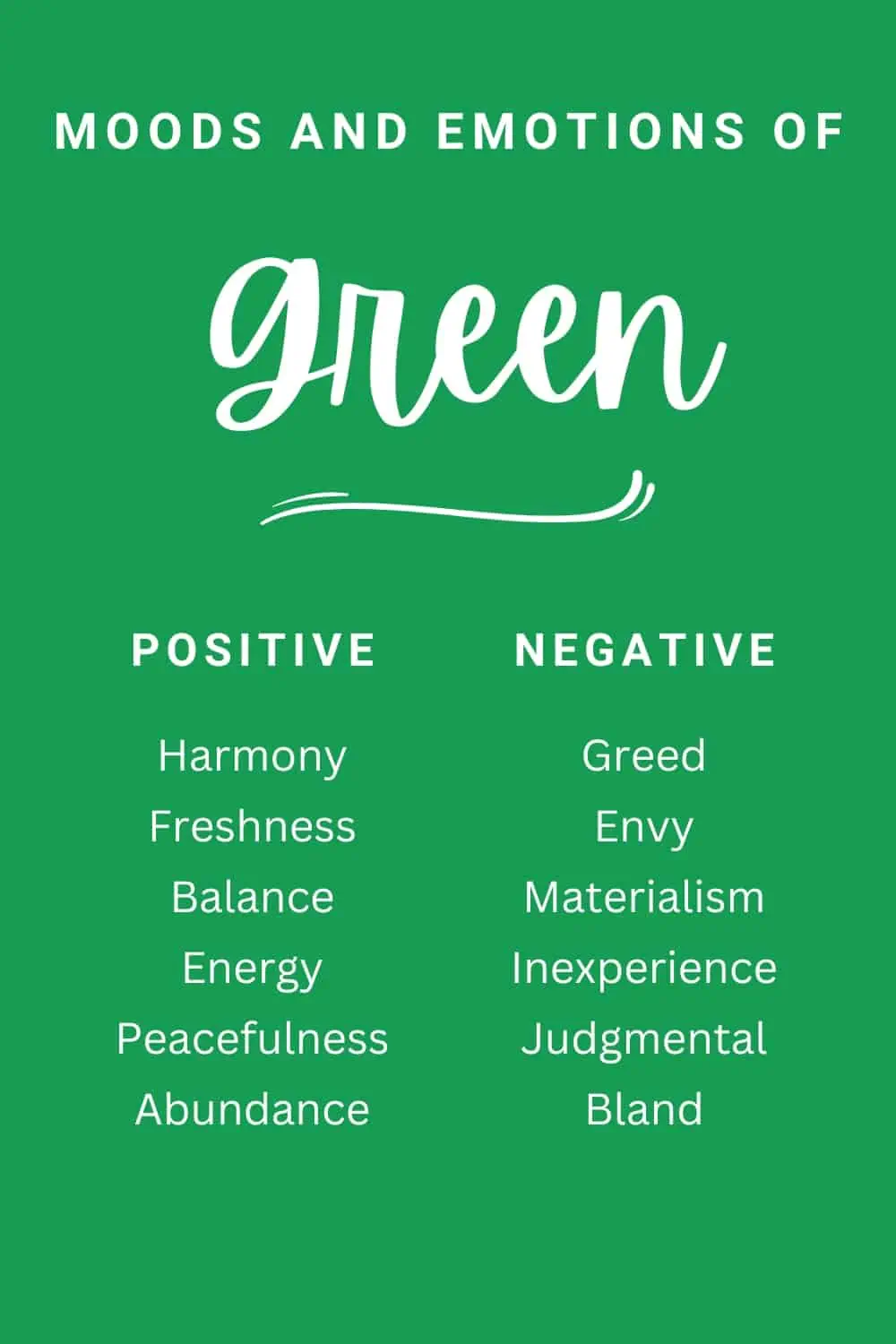
Green evokes feelings of harmony, hopefulness, abundance, and prosperity. Moreover, green is seen as a sign of balance, safety, and growth.
Furthermore, this color is also revitalizing, comforting, relaxing, and balancing. It is a healing color that can keep stress at bay.
It is the color of nature and fertility and is therefore associated with emotions such as balance and harmony. Also, businesses often use green as a sign of sustainability or as an eco-friendly brand.
But that’s not all. The idiom “green light” means to go further, and its meaning comes from the green color of the traffic lights. This was chosen because it has the next wavelength after red and yellow. So it is easier to see it than other colors.
In web design, green is associated with positive things. It is often used for call-to-action buttons to move forward in the navigation flow.
Just like any other color, it also conveys less positive emotions. The negative emotions of green include jealousy and envy.
Blue
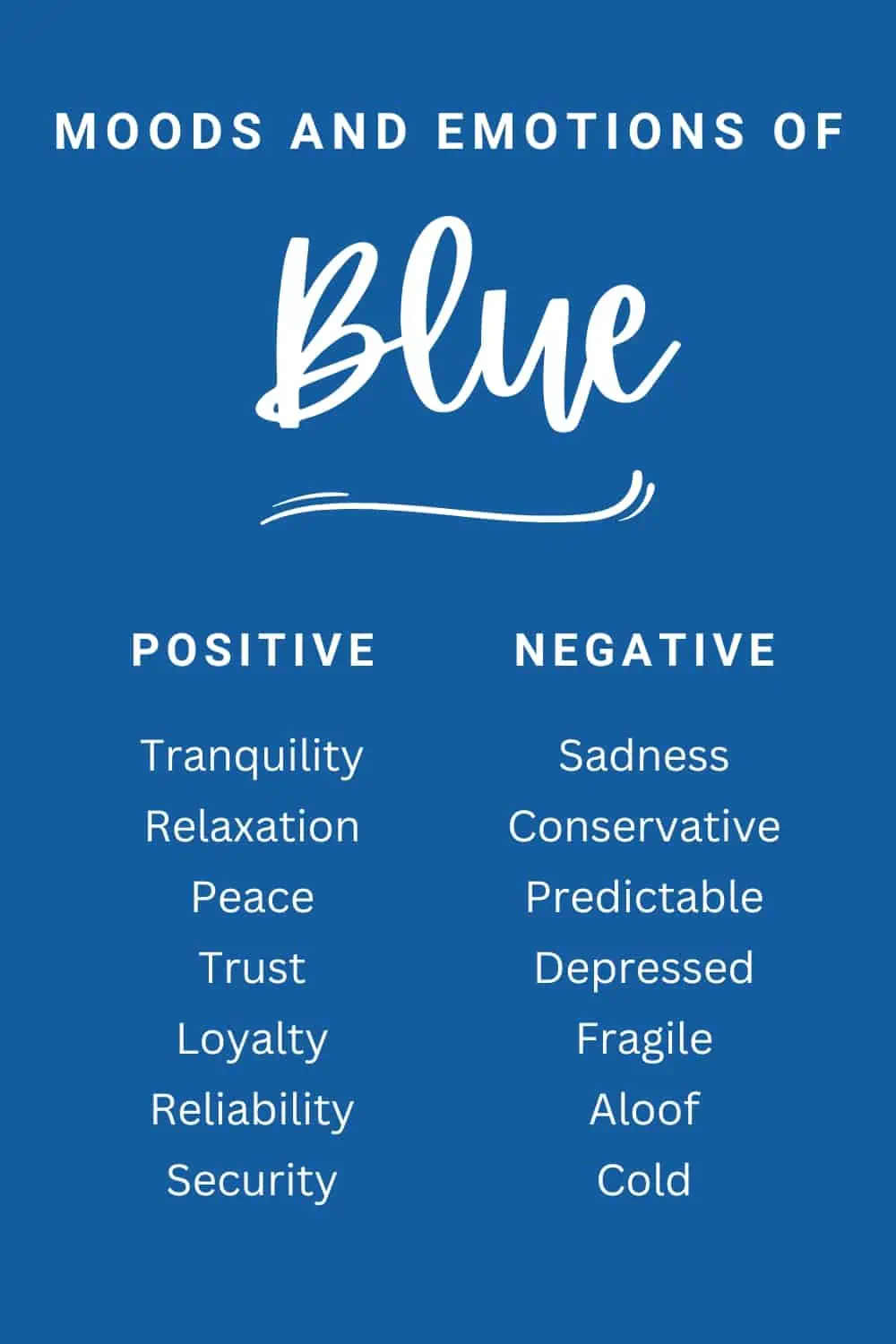
If you are looking for a color of peacefulness and tranquility, blue is the best choice.
Blue is the color of calm and relaxation. Moreover, blue evokes feelings of honesty, trust, loyalty, reliability, and confidence.
It is also associated with freedom, intuition, inspiration, and imagination since it is the color of the sea and sky.
The emotions of blue can also include melancholy, sadness, aloofness, or self-centeredness. Although some see it as a color of sadness, blue is peaceful, inspiring, and relaxing for others.
Blue is not sad, but night-time exposure to blue light can lead to sadness or depression. Scientists say that night-time exposure to blue light disrupts the sleep/wake cycle. This cycle is also called the circadian rhythm, and disruption of the circadian rhythm leads to symptoms of depression.
That is why blue has been attached to that feeling. Moreover, it can give off a sense of coldness. This can also be explained by physics, as it is located near the end of the color spectrum, before violet. The closer we get to the cool end of the visible spectrum, the cooler the emotions evoked by colors.
Violet & Purple
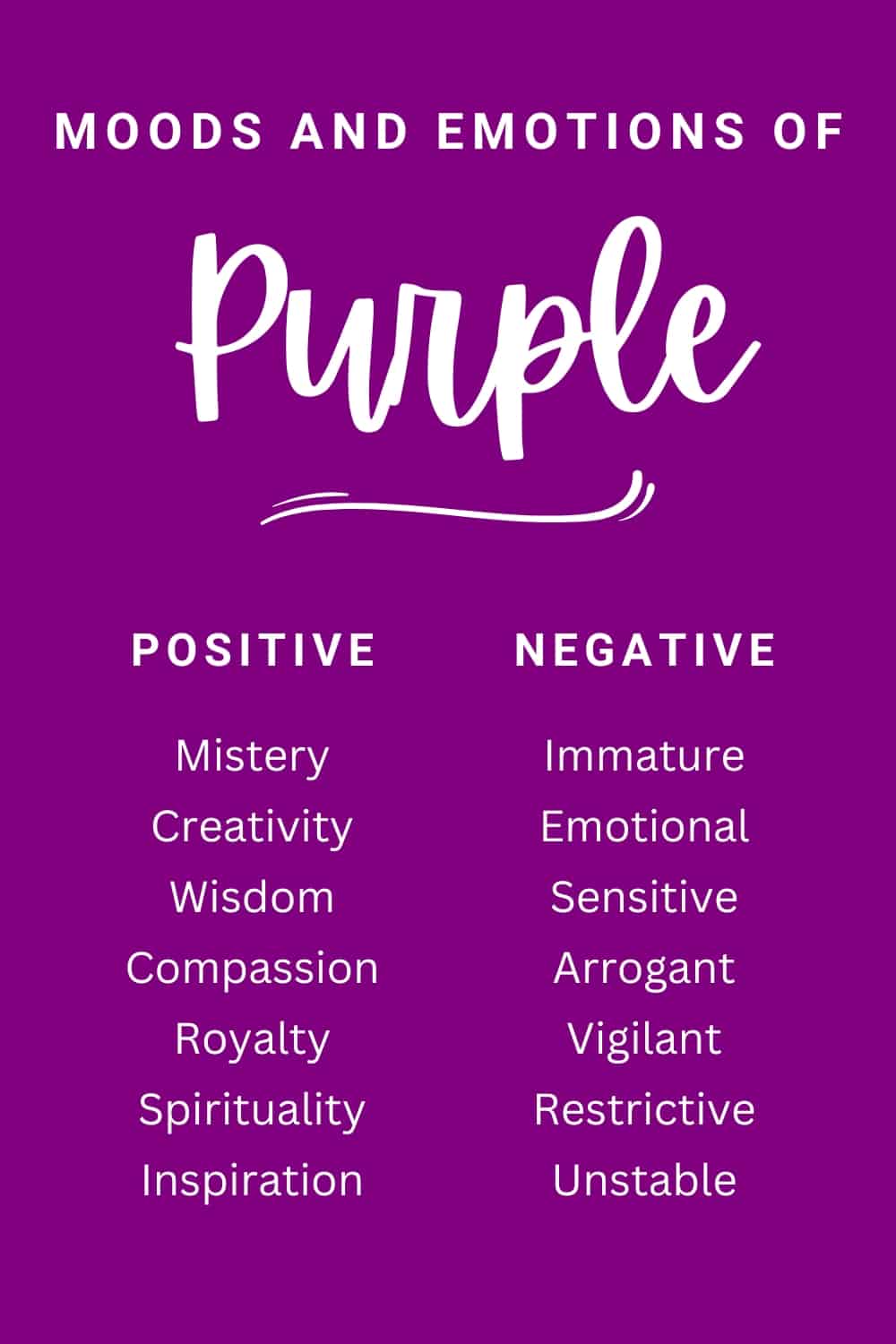
The color violet is associated with creativity, sensitivity, wisdom, and intuition. It also motivates, inspires, and uplifts.
On the other side, purple represents feelings of compassion, enlightenment, and creativity.
Sometimes purple can be perceived as emotional, unstable, arrogant, or immature. Furthermore, violet is associated with hypersensitivity and narcissism.
Depending on the shade of purple, it can be associated with different feelings. Violet is intuitive and meditative; Purple is exciting and expressive; Lavender is nostalgic and romantic; Mauve is thoughtful and sentimental; Amethyst is peaceful and protective;
Brown
Brown is associated with feelings of comfort, honesty, stability, and reliability. What’s more, brown helps you stay grounded and appreciate the simple things in life.
Thanks to its earthy tones, brown represents resilience, safety, and security. Brown is the color of comfort, evoking strength, warmth, and dependability.
However, brown also evokes feelings of sadness, loneliness, and isolation.
Color Psychology as Therapy
Color therapy, sometimes called chromotherapy, is a type of therapy or a method of treatment that uses the colors of the light spectrum to heal various health problems. [1]
Thus, this method of color therapy involves color light. This means it uses the colors of electromagnetic radiation to heal.
Ancient Egyptian and Chinese cultures used this treatment method to heal for centuries.
In chromotherapy, the colors of light have different physical effects.
- Red increases the pulse and heart rate. Thus, it raises the levels of excitement and blood pressure. Furthermore, red stimulates appetite by enhancing metabolism, which is why it is among the most popular colors in restaurants.
- Orange stimulates digestion, the respiratory system, and the lungs because it combines red’s circulation-stimulating effect with yellow’s nerve-stimulating ability.
- Yellow stimulates the nervous system and keeps melancholic and depressive moods at bay.
- Blue decreases blood pressure and excitement levels. [2] Despite this, blue light increases reaction time and improves attention. On the other hand, it suppresses the body’s release of melatonin twice as much as green and can affect the circadian rhythm. This means staying in blue light before going to bed is not recommended.
- Green alters serotonin secretion in the body and can reduce pain by impacting the endogenous opioid system – which is known to be responsible for pain relief.
- Indigo is said to help relieve tension headaches and migraines. It also helps to soothe skin eruptions and alleviate skin problems.
Red stimulates blood circulation. However, it is not so stimulating for the nerves. On the other hand, yellow and orange stimulate the nerves.
Moreover, blue and purple are relaxing and soothing. It is also said that exposure to blue light can have anti-inflammatory properties.
Interesting Facts of Color Psychology
Although many psychologists consider the color effects often exaggerated, they can alter your mood. But only temporarily.
This means that exposure to red can make you more energetic for a short time.
That said, some studies have found that color can affect people in the most unusual ways:
Red causes you to react faster and more forcefully. So it’s helpful during sporting activities. It is also associated with an enhanced metabolism leading to increased appetite. Furthermore, it can increase blood pressure.
If red is the color that increases appetite, blue is the least appetizing of the colors. That’s because blue in food is associated with poisonous things.
Blue is a color that affects you mentally rather than physically. While bold shades of blue stimulate clarity of thought, light shades improve concentration and calm the mind. [3]
Blue light at night affects the body’s circadian rhythm by suppressing melatonin production. Thus, it affects the quality of sleep.
On the other hand, exposure to blue light increases concentration and performance on attention-based tasks.
The use of blue in web design increases the level of trust of the audience.
Although blue is associated with sadness, one study claims it has positive effects on mental health, possibly depression. [4]
Pink helps you feel calm and can reduce anxiety. Thanks to this effect, it has been used in prisons to calm inmates.
Exposure to warm colors such as red, orange or yellow can increase body temperature, while cool colors act the opposite.
Yellow stimulates the production of serotonin, a happy chemical that acts like a mood stabilizer. It also increases concentration levels. Moreover, yellow is the color of emotions and can improve creativity and self-esteem.
People who live further from the equator or in countries with rainy climates are more likely to associate yellow with joyful emotions than those who experience sunny weather most of the year. [5]
Orange is a highly stimulating yet friendly color. As a mix of red and yellow, orange increases your competition level and can make you more outgoing. What’s more, it helps you feel physically stronger.
When it comes to green, natural green environments help you recover faster after surgery.
Seeing green while walking reduces physiological activation in your body compared to red or white. This means lower heart rate values. [6]
History of Color Psychology
Color psychology is relatively recent. However, colors have been used since ancient cultures to influence emotions, behaviors, and moods or even to treat various ailments.
In 1666, scientist Sir Isaac Newton discovered that passing white light through a prism splits light into all the visible spectrum colors. Also, if you pass the light of the spectrum colors through a prism, you get white light. He also discovered that each color has an associated wavelength range.
In the 19th century, Johann Wolfgang von Goethe began to study the effects of colors on people. In 1810, he published a book called ‘Theory of Colors,’ which is still a mainstay of color psychology today.
In the middle of the 20th century, the Swiss psychologist Max Lüscher created a psychological test (the Lüscher color test) considering that sensory perception of color is objective instead of subjective color preferences.
With this test, the psychologist believed a person’s personality traits could be identified based on color choice.
Thus, he said that the choice of color takes place unconsciously, revealing people as they really are.
The Lüscher test was later used to diagnose mental disorders.
Although the psychology of color has yet to be studied enough through scientific circumstances, colors have become a subject of interest in marketing and design since the 1960s.
This interest came as a result of the desire of big brands to connect emotionally with their audience.
Nowadays, color psychology has begun to be explored for use in therapy.
Color therapy can improve people’s physical and mental states while simultaneously harmonizing the energies that flow through our bodies.
Color Feelings Chart Summary
| Hue | Color Name | Color Emotions |
|---|---|---|
| Red | Energy, passion, strength, confidence, courage, anger | |
| Orange | Optimism, enthusiasm, adventure, warmth, impatience | |
| Yellow | Happiness, joy, fun, creativity, intellect, cowardice | |
| Green | Harmony, safety, balance, growth, abundance, hope, envy | |
| Turquoise | Calmness, compassion, peace, concentration, narcissism | |
| Blue | Tranquility, trust, loyalty, reliability, conservative | |
| Purple | Imagination, mystery, spirituality, wisdom, over-emotional | |
| Pink | Love, compassion, kindness, romance, immature | |
| Brown | Comfort, stability, honesty, reliability, dull | |
| Black | Power, elegance, sophistication, authority, pessimism | |
| Gray | Neutral, conservative, reliability, maturity, sadness | |
| White | Innocence, cleanliness, simplicity, openness, distant |
Frequently Asked Questions
What Colors Represent Happiness?
Yellow and orange are the colors that represent happiness. Yellow is the color of happiness, associated with emotions of joy, fun, and creativity. On the other hand, orange represents enthusiasm, positivity, youthfulness, and spontaneity.
What is the Color of Sadness?
Gray is the color of sadness, followed by black and violet. Moreover, dark and low-saturated cool colors like blue, green, or neutrals like brown are also associated with sadness.
What Are the Colors of Anger?
The colors of anger are red and yellow. Red is the color of anger, danger, revenge, and aggression. In addition, overexposure to yellow can create feelings of anger and frustration. However, the negative emotions evoked by red are more intense.
What Mood Is Purple?
Purple represents feelings of compassion, wisdom, mystery, and creativity. However, the emotions conveyed vary depending on the shade. For example, lavender is romantic and nostalgic, while purple is sensitive and mysterious. On the other hand, mauve is nostalgic and sentimental, while violet is intuitive and meditative.
What are the Moods of Colors?
Moods are impacted by color. Here are the most important color moods:
- Red: passionate, energetic, and excited.
- Pink: calm, reserved, and kind.
- Orange: enthusiastic, adventurous, and joyful.
- Yellow: happy, optimistic, and creative.
- Blue: tranquil, loyal, and trustworthy.
- Green: peaceful, relaxing, and generous.
- Black: powerful, sophisticated, and authoritative.
- Purple: mysterious, wise, and creative.
While red represents physical energy, blue represents intellectual stimulation. Green is harmonizing and balancing, while yellow is emotional and radiates positivity.
Did you enjoy this article about the colors of emotions? Share it with friends who might be interested as well.

